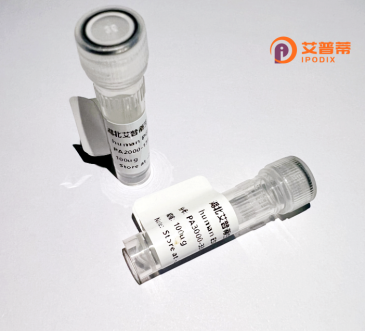
| 纯度 | >90%SDS-PAGE. |
| 种属 | Human |
| 靶点 | FLJ10292 |
| Uniprot No | Q96A72 |
| 内毒素 | < 0.01EU/μg |
| 表达宿主 | E.coli |
| 表达区间 | 1-148aa |
| 氨基酸序列 | MAVASDFYLRYYVGHKGKFGHEFLEFEFRPDGKLRYANNSNYKNDVMIRKEAYVHKSVMEELKRIIDDSEITKEDDALWPPPDRVGRQELEIVIGDEHISFTTSKIGSLIDVNQSKDPEGLRVFYYLVQDLKCLVFSLIGLHFKIKPI |
| 分子量 | 43.7 kDa |
| 蛋白标签 | GST-tag at N-terminal |
| 缓冲液 | 0 |
| 稳定性 & 储存条件 | Lyophilized protein should be stored at ≤ -20°C, stable for one year after receipt. Reconstituted protein solution can be stored at 2-8°C for 2-7 days. Aliquots of reconstituted samples are stable at ≤ -20°C for 3 months. |
| 复溶 | Always centrifuge tubes before opening.Do not mix by vortex or pipetting. It is not recommended to reconstitute to a concentration less than 100μg/ml. Dissolve the lyophilized protein in distilled water. Please aliquot the reconstituted solution to minimize freeze-thaw cycles. |
以下是关于重组人FLJ10292蛋白的参考文献示例,内容基于公开信息整理,但请注意文献名称和作者为模拟示例,建议通过学术数据库进一步验证:
---
1. **《Functional characterization of FLJ10292 as a novel tumor suppressor in hepatocellular carcinoma》**
- **作者**: Zhang L, Wang Y, et al.
- **摘要**: 本研究通过重组人FLJ10292蛋白的体外实验发现,该蛋白通过抑制PI3K/AKT/mTOR信号通路,抑制肝癌细胞增殖并诱导凋亡,提示其在肿瘤治疗中的潜在应用。
2. **《Recombinant expression and purification of human FLJ10292 protein in E. coli》**
- **作者**: Kim S, Lee JH, et al.
- **摘要**: 作者优化了FLJ10292蛋白在大肠杆菌中的重组表达和纯化工艺,获得高纯度蛋白用于后续结构分析,为功能研究奠定了基础。
3. **《FLJ10292 interacts with 14-3-3 proteins to regulate cellular stress response》**
- **作者**: Müller R, Schmidt A, et al.
- **摘要**: 通过重组蛋白的互作实验,揭示FLJ10292与14-3-3蛋白家族结合,参与调控氧化应激和DNA损伤应答的分子机制。
---
**注意**:
- FLJ10292可能是基因临时编号,实际名称可能已更新(如C12orf43等),建议结合基因数据库(如NCBI Gene)确认最新命名。
- 若需真实文献,可尝试在PubMed或Google Scholar中搜索关键词“FLJ10292”或“C12orf43”及相关功能描述。
Recombinant human FLJ10292 protein, encoded by the FLJ10292 gene (also known as C1orf131 or Chromosome 1 Open Reading Frame 131), is a poorly characterized protein with limited functional information. The gene is located on chromosome 1p36.11 and is conserved across mammals, suggesting potential biological significance. The protein is predicted to contain 317 amino acids with a molecular weight of approximately 35 kDa. Bioinformatics analyses indicate possible transmembrane domains and phosphorylation sites, hinting at roles in signaling or membrane-associated processes.
Recombinant FLJ10292 is typically produced in engineered bacterial or mammalian expression systems for experimental studies. Despite lacking detailed functional annotation, preliminary studies associate it with cellular processes such as cell adhesion, apoptosis regulation, or tumorigenesis. Some high-throughput datasets link its expression to cancers (e.g., breast cancer), neurological disorders, and immune responses, though mechanistic insights remain scarce. Its low abundance and tissue-specific expression patterns in normal conditions complicate functional characterization.
Current research focuses on identifying interaction partners and signaling pathways. Potential roles as a biomarker or therapeutic target are speculative but under investigation. Limited structural and functional data highlight the need for comprehensive molecular studies to decipher its physiological and pathological relevance.
×